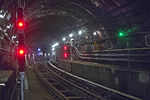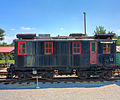Portal:Trains
Portals → Technology → Transport → Trains
The trains portal
|
In rail transport, a train is a vehicle or (more frequently) a string of vehicles capable of being moved along a continuous line of rails or other guideway for the purpose of conveying freight or passengers between points on a predetermined route. The train may be hauled or propelled by one or more vehicles designed exclusively for that purpose (locomotives) or may be driven by a number of motors incorporated in all or several of the vehicles (multiple units). As of 2018[update], there are approximately 1,052,000 kilometres (654,000 mi) of railway track in use worldwide. (World Bank (via Archive.org)) |
|
Selected article of the week
The New York City Subway signaling system currently uses Automatic Block Signaling, with fixed wayside signals and automatic train stops. Many portions of the signaling system were installed between the 1930s and 1960s and most trains on the system are manually operated. Because of the age of the subway system, many replacement parts are unavailable from signaling suppliers and must be custom built for the New York City Transit Authority, which operates the subway. There are two different schemes of signaling in the system. The most used scheme is used on all B Division lines, originally built to the Brooklyn–Manhattan Transit Corporation (BMT) and Independent Subway System (IND)'s wider specifications, and on most of the A Division lines, built to the narrower specifications of the Interborough Rapid Transit Company (IRT). As part of the modernization of the New York City Subway, the MTA plans to upgrade much of the system with communications-based train control (CBTC) technology, which will control the speed, and starting and stopping, of subway trains. The CBTC system is mostly automated and uses a moving block system—which reduces headways between trains, increases train frequencies and capacities, and relays the trains' positions to a control room—rather than a fixed block system. The implementation of CBTC requires new rolling stock to be built for the subway routes using the technology, as only newer trains use CBTC.
Recently selected: King's Cross St Pancras tube station - International (Amtrak train) - Hunts Point Avenue station
Selected image of the week
A Panama Railroad passenger train led by a 2-6-0 steam locomotive poses for a photograph at Panama City station in the early 20th century.
Recently selected: GATX tank cars in Austria - Cuban sugar cane train - České dráhy diesel railcar
Did you know...
- ...that the opening ceremonies of the Galway to Clifden railway were very sparsely attended because the event date was a strict church holiday and was reserved for attending church services?
- ...that following heavy damage to the Galveston Island Trolley track and cars from Hurricane Ike in 2008, substitute service with replica buses was operated until service resumed in October 2021?
- ...that although the former Santa Fe Railway's Galesburg station was demolished after regular passenger service to the station ended in 1996, the site is still used if derailments cause trains to use the Chillicothe Subdivision instead of the Mendota Subdivision?
- ...that the Fuzhou–Xiamen railway, which opened in 2010, was so heavily used that it reached capacity in 2015, spurring construction on the parallel Fuzhou–Xiamen high-speed railway for CRH passenger train services?
Selected anniversaries
- October 9
- 1865 – George Hughes, Chief Mechanical Engineer for the Lancashire and Yorkshire Railway 1904–1922, the London and North Western Railway 1922–1923 and the London, Midland and Scottish Railway 1925–1931, is born (d. 1945).
- 1877 – The steam locomotive Countess of Dufferin (pictured), the first locomotive to operate in Manitoba and the first locomotive on the Canadian prairies, arrives aboard a barge in St. Boniface (now an electoral district of Winnipeg).
- 1909 – The Alaska Northern Railroad Company (a predecessor of the Alaska Railroad) purchases the assets of the bankrupt Alaska Central Railway and subsequently extends the line northward another 34 kilometers (21 mi).
- 2001 – Canadian National Railway (CN) purchases Wisconsin Central for $1.2 billion, giving CN a direct rail link to Chicago, Illinois.
Train News
- July 24, 2021 – Atchison, Topeka and Santa Fe No. 2926, a 4-8-4 steam locomotive built by Baldwin Locomotive Works in 1944, moves under its own power for the first time since Christmas Eve of 1953, after nearly twenty-two years of being rebuilt by volunteers. The locomotive will be put into mainline excursion service. (NMSL&RHS, Trains Magazine on Facebook)
- May 5, 2021 – Steamtown National Historic Site completes thorough cosmetic overhaul on Union Pacific 4-8-8-4 Big Boy No. 4012, which is moved back on static display before National Train Day. (NEPA Scene)
- April 2, 2021 – 2021 Hualien train derailment – A Taroko Express train operated by the Taiwan Railways Administration (TRA) derails at the north entrance of Qingshui Tunnel in Heren Section, Xiulin Township, Hualien County, Taiwan, killing 49 people and injuring at least 200 others. North of Hualien City a construction truck had fallen down a slope onto the tracks. The eight-carriage train derailed after colliding with the truck, and then came to a rest in the tunnel, with severe damage and many casualties. (Bloomberg, CNN, CNA, New York Times, Financial Times)
- December 31, 2020 – Following a complete restoration, Chesapeake and Ohio 1309, a 2-6-6-2 Mallet locomotive built by Baldwin Locomotive Works in 1949, the last steam locomotive built by Baldwin for the North American market, is operated under its own power for test runs. When returned to service on the Western Maryland Scenic Railroad, it will be the largest steam locomotive in regular scheduled service in the United States and take 2-8-0 No. 734’s place as the largest active steam locomotive in the state of Maryland. (Trains.com Newswire)
- September 28, 2020 – Amtrak operates a test run using one of the 28 new Avelia Liberty trains manufactured by Alstom along the full length of the Northeast Corridor to Boston South Station. Previous test runs had occurred from Washington, D.C., only as far north as New Jersey and Delaware. Barring any problems, the trains are expected to enter regular service on the route in 2021. (Universal Hub)
- June 13, 2020 – The Bay Area Rapid Transit Silicon Valley BART extension opened its stations in Milpitas and North San Jose. (San Jose Spotlight, SF Gate)
General images
WikiProjects
WikiProject Trains (Shortcut: WP:TWP)
- WikiProject Stations (WP:STA)
- WikiProject Streetcars (WP:TRAM)
- WikiProject Rapid transit (WP:RTPJ) inactive
- By region:
- WikiProject Metros of the former Soviet Union (WP:SOVMETRO) inactive
- WikiProject Indian railways (WP:INRW)
- WikiProject Trains in Japan (WP:TJ)
- WikiProject New Zealand Railways (WP:NZR)
- WikiProject Pakistan Railways (WP:PKR) inactive
- United Kingdom
- United States
- Fictional rail transport topics:
Note: WikiProjects marked as inactive are retained pending future editing activity
Subcategories
Things you can do
See also Wikipedia:WikiProject Trains/Todo and Wikipedia:Pages needing attention/Railroads
Associated Wikimedia
The following Wikimedia Foundation sister projects provide more on this subject:
-
Commons
Free media repository -
Wikibooks
Free textbooks and manuals -
Wikidata
Free knowledge base -
Wikinews
Free-content news -
Wikiquote
Collection of quotations -
Wikisource
Free-content library -
Wikiversity
Free learning tools -
Wiktionary
Dictionary and thesaurus
























































































